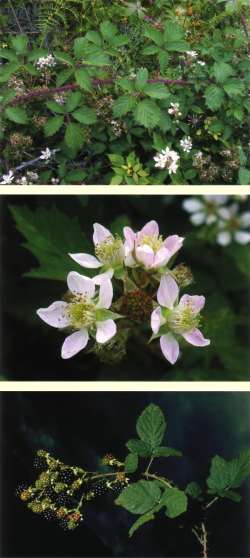|
 An
Illustrated Guide to An
Illustrated Guide to
Common Weeds
of New Zealand
Rubus
fruticosus
blackberry
Family
ROSACEAE
Reproduced from
Common
Weeds of New Zealand
by Ian Popay, Paul Champion & Trevor James
ISBN 0 473 09760 5
by kind permission of the
New
Zealand Plant Protection Society
Publication or other use of images or descriptive
text on these pages is unauthorised unless written permission is
obtained from the authors and publisher.
Appropriate acknowledgement
of the publication Common Weeds of New Zealand must always
be given.
Available from Nationwide Book Distributors
 Very
prickly, scrambling, woody perennial shrub up to 2 m or more tall,
bearing large white or pink flowers followed by black berries. Extremely
variable in leaf shape and plant form. Very
prickly, scrambling, woody perennial shrub up to 2 m or more tall,
bearing large white or pink flowers followed by black berries. Extremely
variable in leaf shape and plant form.
- Flowers
White to pink, 2-3 cm in diameter, with five petals and numerous
stamens, in many-flowered clusters. Flowers Nov-Apr.
- Fruit
Aggregated berries 10-15 mm long, red at first, turning black
when ripe, made up of twenty to fifty two-seeded drupelets. Seeds
widely spread by birds.
- Leaves
Compound, three to five, oval, toothed leaflets arranged palmately.
Stalks and mid-ribs prickly.
- Stems
Up to 8 m long, arching, entangling, woody, armed with savage
backward pointing thorns. Stems rooting at tips to form new plants.
New stems grow from the base each year.
- Roots
Stout, branched, creeping underground roots.
Habitat
Reverting land, scrub,
road-sides, hedgerows, swamps and waste places.
Distribution
Common to locally abundant
throughout NZ including Stewart and Chatham Islands. Originally
from temperate northern hemisphere regions.
Comments
Very common nuisance
weed. Can become a major weed of pastures in some areas, like
Wairoa. A preferred food for goats, which control it effectively,
but need to be confined with it. Otherwise, control can be difficult.
Seedlings are very slow growing, and can be controlled by moderate
grazing pressure. The species is extremely variable and has sometimes
been divided into many species and very many varieties. One of
the more distinctive, sometimes distinguished as a separate species,
is cut-leaved blackberry (Rubus laciniatus). All blackberries
are subject to Pest Plant Management Strategies in several regions
of NZ. Details are available from individual regional councils
or unitary authorities.
Related
species
Other species of Rubus
include the native bush lawyers (Rubus australis, Rubus
cissoides and Rubus schmidelioides), with long,
semi-woody stems, sprawling or climbing in native forest and bush
margins. They have backward-pointing spines that often hinder
the progress of humans or animals through the bush.
Derivation
of botanical name
Rubus (Lat.)
= bramble; fruticosus (Lat.) = bushy.
Web-notes:
Weed Links
On this site
Reproduced from Common Weeds
of New Zealand:
External Links
 Weedbusters
New Zealand Weedbusters
New Zealand
- Weedbusters is a weeds awareness and education programme that aims to
protect New Zealand's environment from the increasing weed problem.
- AgPest
- A free tool to assist farmers and agricultural professionals in decision-making regarding weed and pest identification, biology, impact and management.
 New Zealand Weeds Key New Zealand Weeds Key
- An interactive identification key to the weeds of New Zealand. Developed at Landcare Research.
New
Zealand Plant Conservation Network naturalised plants
- Search for information on more than 2500 naturalised and weedy plants.
 New
Zealand Plant Protection Society New
Zealand Plant Protection Society
- Their main objective: "To pool and exchange information on the biology
of weeds, invertebrate and vertebrate pests, pathogens and beneficial organisms
and methods for modifying their effects."
-
 Massey
University Weeds Database Massey
University Weeds Database- A site providing information about New Zealand weeds and weed control.
It has a series of pages showing pictures of New Zealand weeds, notes on
identification and control. It also provides information on a university
paper entitled Controlling Weeds.
-
-
More
Plant Profiles
|



 Very
prickly, scrambling, woody perennial shrub up to 2 m or more tall,
bearing large white or pink flowers followed by black berries. Extremely
variable in leaf shape and plant form.
Very
prickly, scrambling, woody perennial shrub up to 2 m or more tall,
bearing large white or pink flowers followed by black berries. Extremely
variable in leaf shape and plant form.


